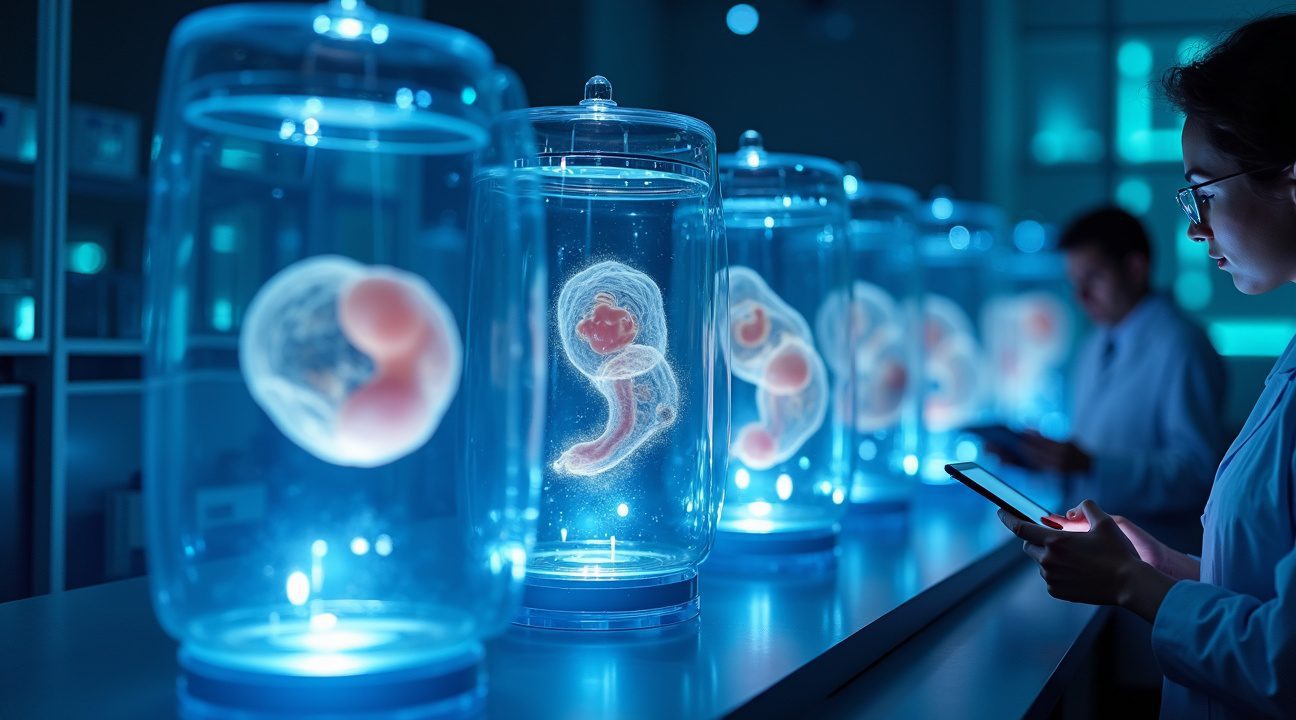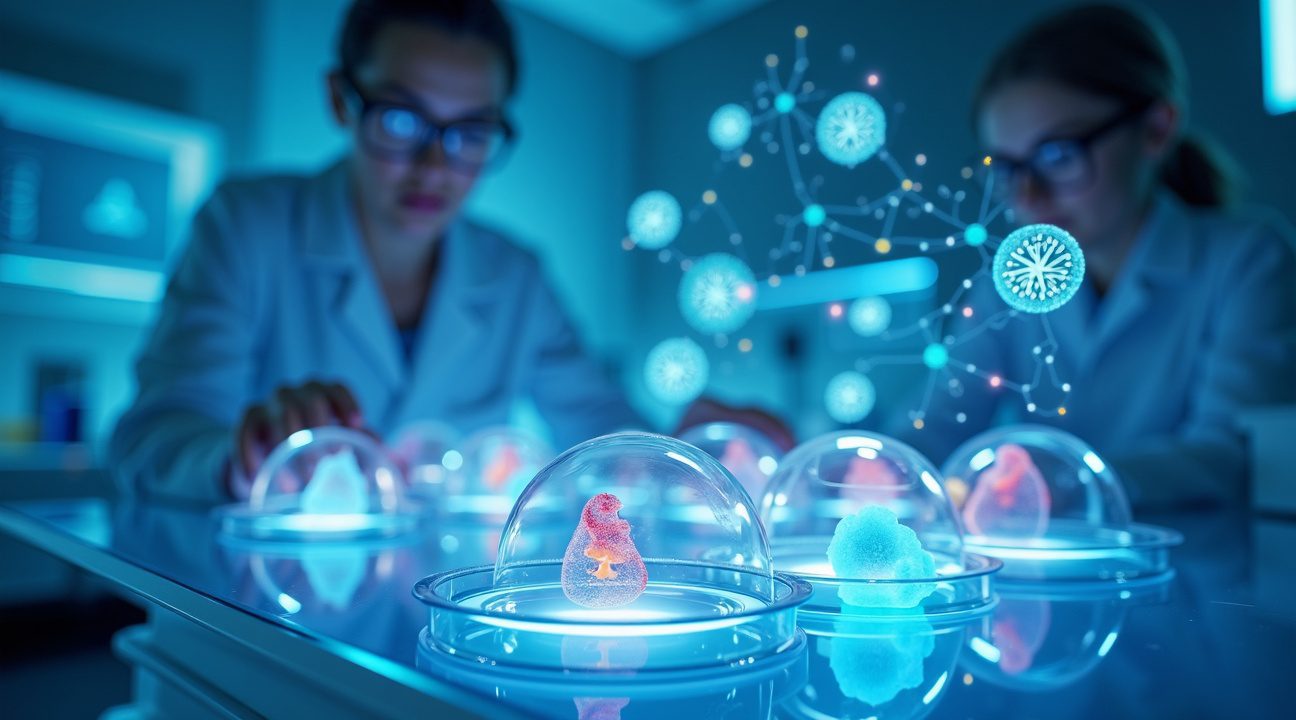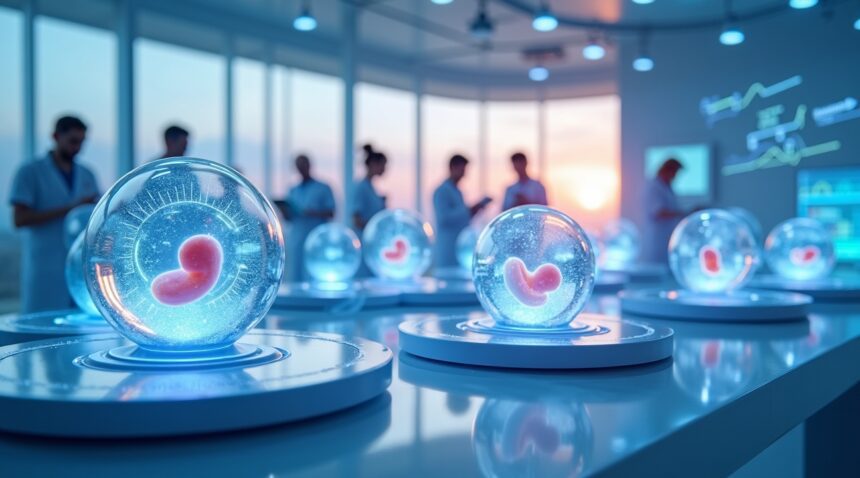Prof. Jacob Hanna and his team at the Weizmann Institute of Science have achieved a scientific milestone by creating complete human embryo models from stem cells that develop independently for 14 days—with no requirement for sperm, eggs, or a womb.
Breakthrough in Embryo Model Development
In a major advancement in developmental biology, scientists used reprogrammed stem cells in a “naïve” state to create synthetic human embryo models. These models replicate the conditions of a 14-day-old natural embryo entirely under laboratory conditions. Unlike previous models that resulted in disorganized cell clusters, these new embryos form complex, organized structures including a placenta, yolk sac, and chorionic sac.
Key Takeaways
- Reprogrammed stem cells were used to generate complete embryo models in a controlled lab environment.
- The synthetic embryos include structures like the placenta and yolk sac, critical to early development.
- The models provide a new platform for studying early genetic disorders, testing medications, and uncovering miscarriage causes.
- The technology supports drug testing and could pave the way for personalized medical treatments and new clinical insights.
- Regulatory challenges may arise as these synthetic embryos evolve beyond traditional 14-day research limits, prompting ethical and scientific debate on potential extensions to 28 days.
Implications for Ethics and Future Research
This development not only provides an alternative to using natural embryos but also minimizes the associated ethical concerns. Scientists now have unprecedented insight into the earliest stages of human growth, an area traditionally restricted due to the limitations on embryo research.
The breakthrough could influence global guidelines and spark new discussions on extending the current 14-day rule to accommodate future research needs. For a detailed overview, you can refer to the full report published by the Weizmann Institute of Science.
Complete 14-Day Embryo Models Grown Without Natural Reproduction
Prof. Jacob Hanna and his team at the Weizmann Institute of Science have achieved a remarkable breakthrough in developmental biology. I’ve witnessed many scientific advances, but their success in creating complete human embryo models from stem cells represents something truly extraordinary. These synthetic embryo models (SEMs) develop entirely outside a womb and require neither sperm nor eggs to form.
The team’s embryo-like models reach day 14 of development, a critical milestone in human embryogenesis. Unlike previous attempts that produced basic cell clusters, these models contain all the essential structures found in natural embryos at this stage. They include a properly formed placenta, yolk sac, chorionic sac, and the relevant external tissues that support healthy development.
Structural Completeness Sets New Standards
What makes these models revolutionary is their comprehensive organization. Earlier stem cell aggregates lacked the vital structures necessary for proper embryonic development. I can see how this limitation prevented researchers from studying the complex interactions between different embryonic compartments. Hanna’s team overcame these challenges by using naïve stem cells and advanced cultivation techniques that allow dynamic, normal growth patterns to emerge.
The 14-day timeframe is particularly significant because this marks the point where organ progenitor formation begins. Scientists have long struggled to understand this crucial period of human development due to ethical restrictions on embryo research. These synthetic models provide an unprecedented window into early human development without the ethical concerns surrounding natural embryos.
Revolutionary Applications for Medical Research
The implications extend far beyond basic research. These embryo-like structures offer researchers several groundbreaking opportunities:
- Disease modeling for genetic disorders that affect early development
- Drug testing platforms for pregnancy-related medications
- Understanding miscarriage causes and prevention strategies
- Studying birth defects and developmental abnormalities
- Advancing fertility treatments and reproductive medicine
The models’ ability to mimic natural embryonic organization means researchers can now study how different embryonic compartments communicate with each other. This interaction between the developing embryo and its supporting structures has been largely mysterious until now. The placenta formation process, in particular, offers insights into pregnancy complications that affect millions of women worldwide.
Pluripotent stem cells serve as the foundation for this technology, demonstrating their remarkable potential to recreate complex biological systems. The research builds upon decades of stem cell science, but Hanna’s approach represents a quantum leap in sophistication. Previous attempts to model early human development fell short because they couldn’t replicate the intricate structural relationships that define proper embryonic growth.
The timing couldn’t be more significant for medical research. With increasing concerns about scientific data preservation and the need for reproducible research methods, these synthetic models provide a standardized platform for studying human development. The controlled environment allows researchers to manipulate specific variables and observe their effects on embryonic growth patterns.
This breakthrough also addresses practical limitations in traditional embryo research. Natural embryos are scarce, difficult to obtain, and subject to strict ethical guidelines that limit research duration. The synthetic models eliminate these constraints while providing consistent, reproducible results that advance our understanding of human biology.
The Weizmann Institute’s success demonstrates how innovative approaches to stem cell manipulation can unlock new research possibilities. By creating embryo-like structures that faithfully represent natural development, scientists now have tools to investigate questions that were previously unanswerable. This technology promises to accelerate discoveries in developmental biology and potentially lead to new treatments for developmental disorders and pregnancy complications.

Revolutionary Stem Cell Reprogramming Techniques
The groundbreaking methodology centers on reprogramming human stem cells to achieve a “naïve” state that mirrors the developmental potential of an embryo at implantation, specifically around day 7 of natural development. This reprogramming process transforms cells back to their most versatile form, enabling them to progress through critical early developmental milestones without requiring traditional reproductive processes.
Understanding Naïve Pluripotency in Laboratory Settings
Scientists achieve this remarkable feat by utilizing pluripotent stem cells derived from two distinct sources. The first involves reprogramming adult skin cells back to their naïve state, essentially reversing cellular aging and specialization to restore their capacity for forming any cell type in the human body. The second approach employs established human stem cell lines that researchers have maintained in laboratories for years.
Both approaches bypass the fundamental requirements of natural reproduction—eliminating the need for fertilization between sperm and egg, and removing dependency on a uterine environment. This scientific advancement creates synthetic embryo models that can develop and differentiate in controlled laboratory conditions, offering unprecedented access to study human embryogenesis.
The naïve state represents the pinnacle of cellular flexibility, where stem cells possess maximum pluripotency. In this condition, cells can theoretically differentiate into any of the body’s specialized cell types, from neurons to heart muscle cells. Scientists carefully maintain these cells in specific culture conditions that preserve their developmental potential while preventing unwanted differentiation.
Synthetic Embryo Models Enable Unprecedented Research Access
These synthetic embryo models provide researchers with a scalable and reproducible platform for studying human development that was previously impossible to observe. The techniques overcome significant ethical and practical barriers that have historically limited embryonic research, particularly during the critical period immediately following implantation.
Traditional embryonic research faces substantial limitations because natural embryos implant into the uterine wall, making direct observation and manipulation extremely challenging. These synthetic models eliminate this barrier by developing entirely in laboratory dishes, allowing scientists to monitor every stage of early development in real-time.
The research applications extend far beyond basic developmental biology. Scientists can now:
- Investigate how different genes influence early human development
- Study the formation of specific tissues
- Observe dynamic cellular interactions that shape embryonic growth
This access proves particularly valuable for understanding developmental disorders and congenital conditions that originate during these earliest stages of human life.
Cell differentiation studies become significantly more feasible with these models, as researchers can track how individual cells transform from their naïve state into specialized cell types. The process reveals intricate molecular pathways and timing mechanisms that govern human development, information that could inform regenerative medicine approaches and therapeutic interventions.
The scalability of this approach represents another significant advantage over traditional embryonic research. Scientists can generate multiple synthetic embryo models simultaneously, enabling comparative studies and statistical analysis that would be impossible with naturally conceived embryos. This reproducibility accelerates research timelines and improves the reliability of experimental results.
These synthetic embryo models also offer insights into tissue formation patterns and the spatial organization of developing structures. Researchers can observe how cells communicate with each other during development, how tissues establish their boundaries, and how mechanical forces shape embryonic architecture. Such observations could eventually inform efforts to engineer replacement tissues or organs for medical applications.
The breakthrough connects to broader scientific discoveries about human development and cellular behavior, much like how scientists think they’ve discovered the cause of deja vu through careful observation of neural patterns. These stem cell techniques represent a similar leap forward in understanding complex biological processes through innovative experimental approaches.

Transforming Medical Research and Disease Understanding
These synthetic embryo models represent a groundbreaking shift in how I can study human development and disease. Unlike traditional research methods that rely on animal models or limited human tissue samples, these lab-grown embryos allow scientists to observe critical developmental stages that remain hidden during natural pregnancy. The ability to watch embryonic development unfold in real-time provides unprecedented insights into genetic diseases, early pregnancy loss, and the intricate process of organ formation.
The research potential extends far beyond basic observation. Scientists can now manipulate these embryo models to test theories about developmental biology and verify findings from organoid research with greater accuracy than animal models typically provide. This advancement addresses a critical gap in medical research, where differences between human and animal development often limit the applicability of findings.
Revolutionary Applications in Genetic Research and Therapy
Extended culture of these embryo models opens doors to sophisticated gene editing research using technologies like CRISPR-Cas9. Researchers can now investigate genetic disorders by introducing specific mutations and observing their effects on development in a controlled environment. This capability proves invaluable for understanding conditions that manifest during early embryogenesis, when traditional study methods fall short.
The development of stem cell-derived gametes represents another transformative application. These synthetic reproductive cells could revolutionize infertility treatments and reproductive technologies, offering hope to couples who cannot conceive naturally. Scientists can study how these gametes form and function, potentially leading to more effective fertility solutions.
Key research opportunities include:
- Investigating organ progenitor formation and early tissue specification
- Exploring the molecular causes of early miscarriage and developmental disorders
- Testing potential therapeutics without relying on animal models
- Developing personalized medicine approaches based on individual genetic profiles
- Modeling tissue-specific diseases to understand pathological processes
Drug testing benefits significantly from this technology. Pharmaceutical companies can evaluate compounds for safety and efficacy during critical developmental windows, potentially identifying harmful effects that might not appear in adult cell cultures or animal studies. This approach could reduce both the time and cost of bringing new medications to market while improving their safety profiles.
The personalized medicine applications are particularly exciting. Scientists can create embryo models using stem cells from specific patients, allowing them to study how genetic variations affect development and disease susceptibility. This individualized approach could lead to more targeted treatments and better prediction of therapeutic outcomes.
These advances represent a fundamental shift away from animal testing for certain types of research, addressing both ethical concerns and scientific limitations. The accuracy and human relevance of these models could dramatically improve our understanding of complex biological processes and accelerate the development of new treatments for genetic disorders and developmental diseases.
Challenging the 14-Day Rule: Ethical and Regulatory Implications
The 14-day rule stands as one of the most significant regulatory frameworks in embryo research, yet recent scientific breakthroughs are forcing researchers and ethicists to reconsider its relevance. This international standard, enforced by the Human Fertilisation and Embryology Authority and similar bodies across the UK, US, Canada, and Australia, originally prohibited culturing human embryos beyond day 14 of development. I believe this limitation made sense when researchers couldn’t reliably grow embryos past this stage, but synthetic embryo models have fundamentally changed the landscape.
These lab-grown structures now push well beyond the traditional 14-day boundary, creating embryo-like formations that develop for weeks without requiring sperm, eggs, or a womb. Scientists can observe critical developmental processes that were previously impossible to study, including the formation of neural tubes and early organ development. This advancement has sparked intense debate about whether current embryo regulations remain adequate for governing research that doesn’t technically involve “real” embryos.
The Push for Extended Research Periods
Leading researchers advocate for extending embryo culture limits to 28 days, arguing this timeframe would unlock unprecedented insights into human development. Extended research periods could revolutionize our understanding of genetic disorders, improve gene editing techniques, and advance stem cell-based reproduction therapies. Studies of early neural development, which occurs primarily after day 14, could lead to breakthrough treatments for conditions like spina bifida and other developmental anomalies.
However, this scientific enthusiasm meets significant ethical resistance. Critics worry about the moral status of these synthetic models and question whether they deserve the same protections as natural embryos. The debate intensifies because these structures, while created artificially, exhibit many characteristics of genuine human embryos during crucial developmental stages.
Bioethics experts express particular concern about potential misuse of extended research capabilities. Some fear that relaxed regulations could normalize the creation and manipulation of human-like structures, potentially leading to experiments that cross ethical boundaries. Others argue that scientific discoveries require bold approaches, and overly restrictive rules might prevent life-saving medical advances.
International coordination becomes increasingly important as different countries consider varying approaches to embryo regulations. Scientists worry that inconsistent policies could create research havens in countries with more permissive rules, while potentially stifling progress in regions with stricter limitations. I see this regulatory uncertainty as one of the most significant challenges facing modern embryology research.
Future Applications in Regenerative Medicine and Research
I believe these revolutionary embryo models will transform how scientists approach developmental disorders and regenerative medicine. The ability to create research embryos without traditional conception opens unprecedented opportunities for testing gene therapies with enhanced safety protocols. Scientists can now observe critical developmental processes that occur during the mysterious second week of pregnancy, a period previously inaccessible to researchers.
Revolutionary Research Capabilities
The experimental modeling potential extends far beyond current limitations. Researchers can now study how genetic mutations affect early human development without ethical concerns surrounding traditional embryo research. These stem cell-derived models allow scientists to test therapeutic interventions at the earliest stages of human development, potentially preventing developmental disorders before they manifest.
Gene therapy testing becomes significantly more feasible with these models. Scientists can introduce therapeutic genes and observe their effects on embryonic development in real-time. This capability could lead to breakthrough treatments for conditions like:
- Spina bifida
- Congenital heart defects
- Other developmental abnormalities originating during early pregnancy
Clinical Applications and Treatment Development
The clinical understanding gained from these models could revolutionize prenatal medicine. Scientists can now study the precise molecular mechanisms that control organ formation, cell differentiation, and tissue development during those crucial early days. This knowledge directly translates to improved diagnostic tools and therapeutic strategies for developmental disorders.
These tissue models offer unique advantages for regenerative medicine applications. Scientists can generate specific cell types and tissues by directing the embryo models through controlled developmental pathways. The resulting tissues could serve as:
- Patient-specific transplant materials
- Sources of insight into repairing damaged organs using the body’s own developmental programs
Research restrictions currently limit the full potential of these discoveries. However, if regulatory frameworks evolve to accommodate these new technologies, scientists could develop SCDG-based reproduction methods that address infertility while maintaining strict safety standards. Enhanced monitoring capabilities built into these models allow researchers to track every aspect of development, ensuring any future therapeutic applications meet the highest safety standards.
The models also provide invaluable opportunities to study environmental factors affecting early development. Scientists can expose the embryo models to various conditions and observe how external influences shape developmental outcomes. This research could lead to better understanding of how maternal health, medications, and environmental toxins affect fetal development.
Direct research benefits include the ability to screen potential drugs for developmental toxicity before clinical trials. Pharmaceutical companies can test thousands of compounds on these models, identifying both harmful effects and beneficial therapeutic properties. This screening capability could accelerate the development of safer medications for pregnant women while simultaneously advancing treatments for developmental disorders.
Sources:
Weizmann Institute of Science – “Complete 14-Day Embryo Models Grown Without Natural Reproduction”
Weizmann Institute of Science – “Revolutionary Stem Cell Reprogramming Techniques”


